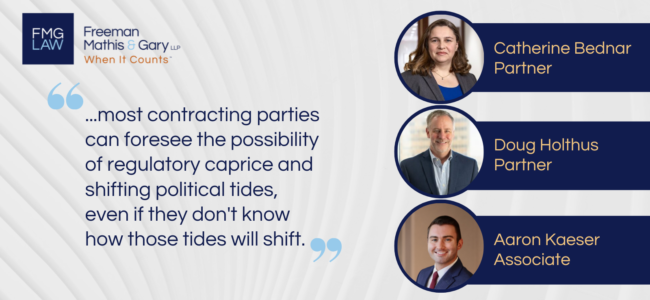BlogLine
Ohio court addresses unforeseen circumstances provision in construction contract
2/18/25

By: Catherine A. Bednar, Doug Holthus, and Aaron N. Kaeser
In Mt. Pleasant Blacktopping Co., Inc. v. Inverness Group, Inc., 2025-Ohio-285 (1st Dist.), Inverness Group, Inc. (“Developer”) had retained Mt. Pleasant Blacktopping Co., Inc. (“Contractor”) for the installation of sanitary sewer lines in a new residential development. The parties’ contract required that the Contractor comply with the county’s Sanitary Engineering Department regulations and to obtain the necessary approvals upon completion of the work. After performing the work, however, inspection showed standing water in the lines; unacceptable conditions. The county’s regulations forced the Contractor to remove and replace the affected lines.
Contractor contested the directive and refused to do so, arguing it was legally and practically impossible to complete its contract because the county had imposed new, stricter standards after Contractor’s work had already been performed. The trial court agreed, finding that the newly enacted regulations were not foreseeable at the time the contract was entered and determined Contractor should not be held liable for failing to comply with standards that had changed during prosecution of the work.
Central to the appeal was the Ohio Supreme Court’s earlier decision in Security Sewage Equip. Co. v. McFerren, 14 Ohio St. 2d 251 (1968), in which the Court recognized an exception to the rule that a party’s failure to obtain a license or regulatory approval will generally not excuse that party’s obligations under a contract when “unforeseen and unusual” regulatory action supervenes “in such a manner beyond the seller’s assumption of risk.” This became known as the “regulatory-impossibility excuse.”
While lack of foreseeability is a necessary element of a regulatory-impossibility defense, alone it is not sufficient to justify excusing performance. “Indeed, if foreseeability were the end-all-be-all, every novel tax or unusual permit restriction might excuse the performance of countless promisors. The performance must also have been rendered impossible or impracticable.”
The appellate court in Mt. Pleasant Blacktopping Co., echoed the Supreme Court’s McFerren standard, holding that a party asserting a defense of regulatory impossibility or impracticability, including under the exception outlined in McFerren, must show (1) that a supervening regulatory action has occurred, (2) that the action was unforeseeable so as to undermine a basic assumption of the bargain, taking into account the parties’ assumption of risk and the realities of industry practice, (3) that the action rendered performance impossible or impracticable under the relevant legal standard, and (4) that the party claiming excuse attempted in good faith to comply with or avoid the application of the relevant regulation.
In light of the appellate court’s explanation, the case was remanded for consideration of whether the county’s regulatory action truly rendered performance legally impossible, and whether the Contractor did all that good faith required before asserting its impossibility excuse.
For entities similarly navigating unpredictability, it is important to remember how courts will analyze risk: only risks that are truly unforeseeable to the parties are not assumed. As the Mt. Pleasant Blacktopping Co. court noted, “[i]n a world of ever-changing regulations, the burden to show unforeseeability will generally be quite high—most contracting parties can foresee the possibility of regulatory caprice and shifting political tides, even if they don’t know how those tides will shift.”
For more information, please contact Catherine A. Bednar at catherine.bednar@fmglaw.com, Doug Holthus at doug.holthus@fmglaw.com, Aaron N. Kaeser at aaron.kaeser@fmglaw.com or your local FMG attorney.
Share
Save Print
